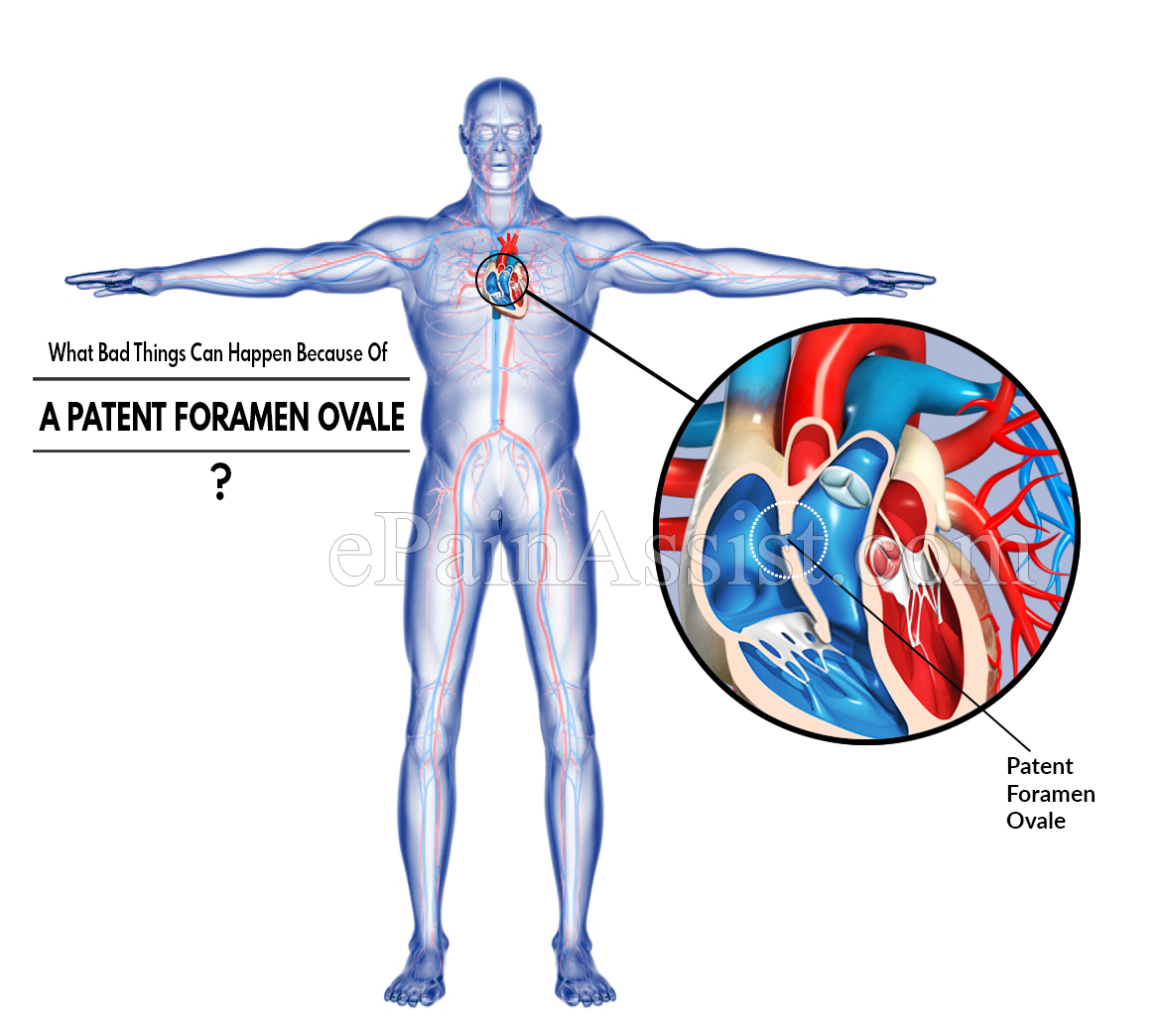PFO allows the irregular flow of blood between the chambers of the heart causing the heart to enlarge and produce an ischemic or cryptogenic stroke.1
In some cases, PFO act as a conduit for blood clots creates a way for a blood clot to travel to the brain resulting in recurrent strokes.2
PFO usually doesn’t require treatment however in patients with a blood clot, your healthcare provider may suggest antiplatelet medicines such as aspirin to help prevent clots.3, 4

What Bad Things Can Happen Because Of A Patent Foramen Ovale?
When the fetus is in the mother’s womb, it breathes through the umbilical cord and there is a hole between the left and right atrium allowing the blood to flow from the placenta to the newborn. However, after birth, when the baby starts to breathe via lungs the hole closes on its own. But when it still exists, the condition is called patent foramen ovale. PFO increases the risk for the below problems
Stroke – Most conditions of PFO don’t produce any sign and symptoms so the vast majority of the individuals never know if they have that condition nor require treatment. However, there can be still blood leakage from the right atrium to the left. This often leads to a problem such as atrial fibrillation.
Although it is not directly associated as a causing factor of stroke, yet it paves the way for the blood clot to travel to the brain and result in a stroke.1
Cryptogenic stroke – A brain infarction not attributable to a definite cardioembolism that blocks blood flow to the brain. Each year, approximately 795,000 individuals are diagnosed with a cryptogenic stroke that designates the category of ischemic stroke. Clinical studies have demonstrated that PFO is often a contributing factor in several unexplained strokes in almost 30 – 50 percent of patients who experienced a cryptogenic stroke.
Your healthcare provider may suggest special medicines that can prevent clots however they are not helpful in the PFO closure. Catheter procedure is the commonly used implantation technique to close the hole and prevent it from happening.2
Should I Take Aspirin If I Have A PFO?
Multiple studies have evaluated preventative strategies for foramen ovale such as surgical closure, cardiac catheter procedure, blood clot prevention by anti-coagulant medicines like aspirin, and medical management with warfarin.
A study was conducted on 13 patients who had a recurrent ischemic stroke and bleeding events. These patients had no history of cardiovascular problems however their death occurred over the follow-up period. Out of the 13 patients, two had a non-disabling stroke and five patients had an ischemic stroke, and bleeding was the most common problem among these patients.
They were taking aspirin for the major intracranial bleeding and the reduction of recurrent strokes. Patients treated with warfarin have been diagnosed to have an enhanced risk of minor hemorrhages compared to aspirin.3, 4
When PFO is sizable it allows a large amount of flow of blood creating pressure and causing your heart to enlarge. Patent foramen transcatheter repair is the common procedure to repair the hole in the heart.
Several closure studies have demonstrated an absolute risk reduction of recurrent strokes in almost 77% of cases. Furthermore, the closing can protect cardiovascular functionalities.
- Meier, B. “Closure of Patent Foramen Ovale: Technique, Pitfalls, Complications, and Follow Up.” Heart (British Cardiac Society), Copyright 2005 by Heart, Apr. 2005, www.ncbi.nlm.nih.gov/pmc/articles/PMC1768795/.
- January 28, 2019 | Heart & Vascular. “I Have a Hole in My Heart. Am I At Risk of Stroke?” Scripps Health, 25 Nov. 2019, www.scripps.org/news_items/6609-what-happens-if-you-have-a-hole-in-your-heart-video.
- “Stroke Prevention in the Setting of a Patent Foramen Ovale: A ‘Hole’ in the Evidence.” Clinical Correlations, www.clinicalcorrelations.org/2011/03/09/stroke-prevention-in-the-setting-of-a-patent-foramen-ovale-a-%E2%80%9Chole%E2%80%9D-in-the-evidence/.
- Wood, Shelley. “Late Follow-up of PFO Closure for Stroke Raises Questions for Antiplatelet Duration.” TCTMD.com, TCTMD.com, 23 Jan. 2019, www.tctmd.com/news/late-follow-pfo-closure-stroke-raises-questions-antiplatelet-duration.
Also Read:
- What is Patent Foramen Ovale (PFO): Causes, Symptoms, Treatment, Diagnosis
- Can I Exercise With A Patent Foramen Ovale & Are There Any Home Remedies?
- How Do You Fix A Patent Foramen Ovale & Can PFO Cause A Heart Attack?
- What Happens If The Patent Foramen Ovale Fails To Close & Can You Live With A PFO?
- Does Patent Foramen Ovale Run In Families & Does A PFO Cause Fatigue?
- Is Patent Foramen Ovale & ASD (Atrial Septal Defect) The Same & Does PFO Cause Arrhythmia?
